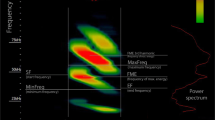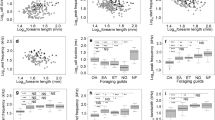Abstract
Different approaches to echolocation in the Microchiroptera, as reflected by differences in call design (frequency, patterns of change of frequency over time), raise an important question, namely can we equate specific call designs with particular foraging strategies? It is difficult to answer the question now because we do not have data on individual variation either in call designs or in foraging strategies. In some species, echolocation calls vary in design (e.g., Rhinopoma hardwickei, Lasiurus cinereus, and some neotropical emballonurids — Habersetzer 1981; Belwood and Fullard 1984; Barclay 1983, respectively), while in others there is no evidence of variation (e.g., Myotis myotis — Neuweiler 1983).
Access this chapter
Tax calculation will be finalised at checkout
Purchases are for personal use only
Preview
Unable to display preview. Download preview PDF.
Similar content being viewed by others
References
Barclay, R.M.R. 1983. Echolocation calls of emballonurid bats from Panama. J. Comp. Physiol., 151: 515–520.
Barclay, R.M.R. 1985. Foraging behavior of the African insectivorous bat, Scotophilus leucogaster. Biotropica, 17: 65–70.
Bell, G.P. and M.B. Fenton. 1984. The use of Doppler-shifted echoes as a flutter detection and clutter rejection system: the echolocation and feeding behavior of Hipposideros ruber (Chiroptera: Hipposideridae). Behay. Ecol. Sociobiol., 16: 343: 347.
Belwood, J.J. and J.H. Fullard. 1984. Echolocation and foraging behaviour in the Hawaiian hoary bat, Lasiurus cinereus semotus. Can. J. Zool., 62: 2113–2120.
Brigham, R.M. and M.B. Fenton. 1986. The influence of roost closure on the roosting and foraging behaviour of Eptesicus fuscus (Chiroptera: Vespertilionidae). Can. J. Zool., 64:1. 128–1. 133.
Fenton, M.B. and G.P. Bell. 1981. Recognition of species of insectivorous bats by their echolocation calls. J. Mamm., 62: 233–243.
Fenton, M.B. and I.L. Rautenbach. 1986. A comparison of the roosting and foraging behaviour of three species of African insectivorous bats (Rhinolophidae, Vespertilionidae and Molossidae). Can. J. Zool., 64: in press.
Fenton, M.B., C.L. Gaudet, and M.L. Leonard. 1983. Feeding behaviour of Nycteris grandis and Nycteris thebaica (Nycteridae) in captivity. J. Zool. London, 200: 347–354.
Fenton, M.B., R.M. Brigham, A.M. Mills and I.L. Rautenbach. 1985. The roosting and foraging areas of Epomophorus wahlbergi (Pteropodidae) and Scotophilus viridis (Vespertilionidae) in Kruger National Park, South Africa. J. Mamm., 66: 461–468.
Fenton, M.B., D.H.M. Cumming, J.M. Hutton and C.M. Swanepoel. 1986. Foraging and habitat use by Nycteris grandis (Chiroptera: Nycteridae) in Zimbabwe. J. Zool., London, in press.
Haberstezer, J. 1981. Adaptive echolocation sounds in the bat Rhinopoma hardwickei, a field study. J. Comp. Physiol., 144: 549–556.
Neuweiler, G. 1983. Echolocation and adaptivity to echological constraints, pp. 280–302 IN Neurethology and behavioral physiology, roots and growing points (F. Huber and H. Markl, eds.). Springer-Verlag, Berlin.
Pennycuick, C.J. 1975. Mechanics of flight, pp. l-75 IN Avian Biology vol. 5 ( D.S. Farner, J.R. King and J.C. Parkes, eds.). Academic Press, London.
Simmons, J.A. and R.A. Stein. 1980. Acoustic imaging in bat sonar: echolocation signals and the evolution of echolocation. J. Comp. Physiol., 135: 61–84.
Vaughan T.A. 1976. Nocturnal behavior of the African false vampire bat, Cardioderma cor. J. Mamm., 67: 227–248.
Vaughan T.A. 1977. Foraging behaviour of the giant leaf-nosed bat (Hipposideros commersoni). East Afr. Wildl. J., 15: 237–259.
Vaughan, T.A. and R.P. Vaughan. 1986. Seasonality and the behavior of the African yellow-winged bat. J. Mamm., 67: 91–102.
Author information
Authors and Affiliations
Editor information
Editors and Affiliations
Rights and permissions
Copyright information
© 1988 Plenum Press, New York
About this chapter
Cite this chapter
Fenton, M.B. (1988). Variation in Foraging Strategies in Five Species of Insectivorous Bats — Implications for Echolocation Call Design. In: Nachtigall, P.E., Moore, P.W.B. (eds) Animal Sonar. NATO ASI Science, vol 156. Springer, Boston, MA. https://doi.org/10.1007/978-1-4684-7493-0_62
Download citation
DOI: https://doi.org/10.1007/978-1-4684-7493-0_62
Publisher Name: Springer, Boston, MA
Print ISBN: 978-1-4684-7495-4
Online ISBN: 978-1-4684-7493-0
eBook Packages: Springer Book Archive




